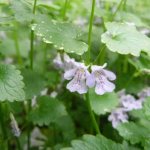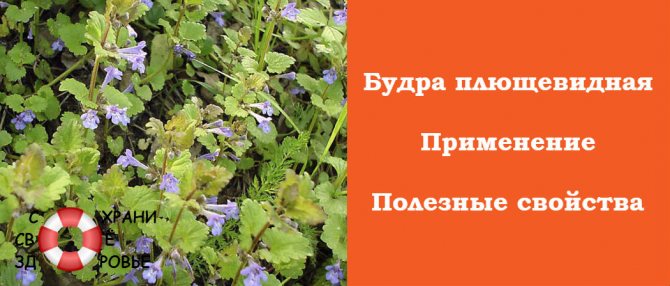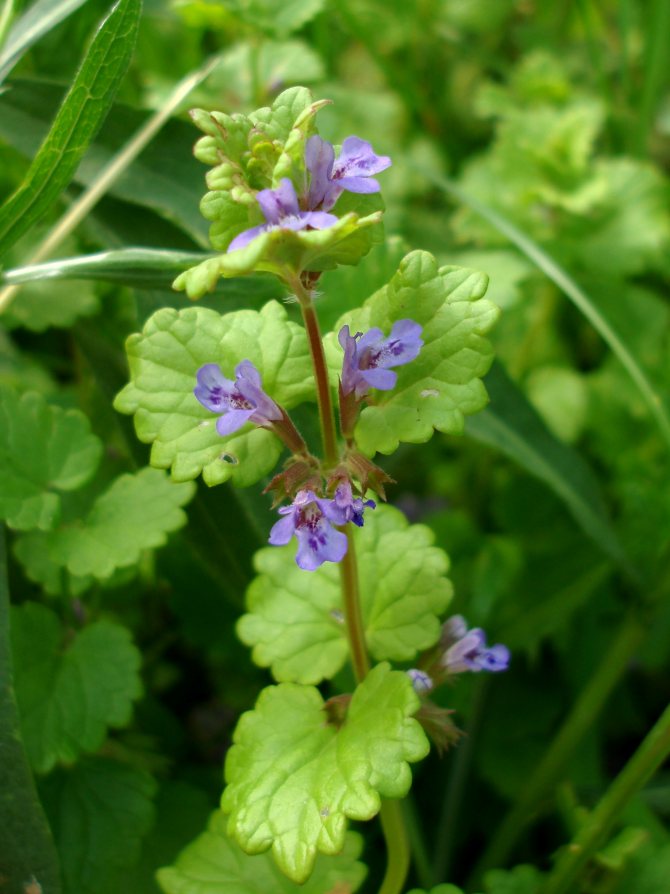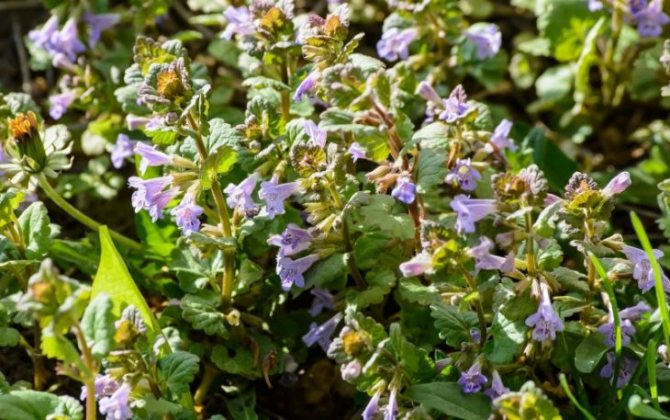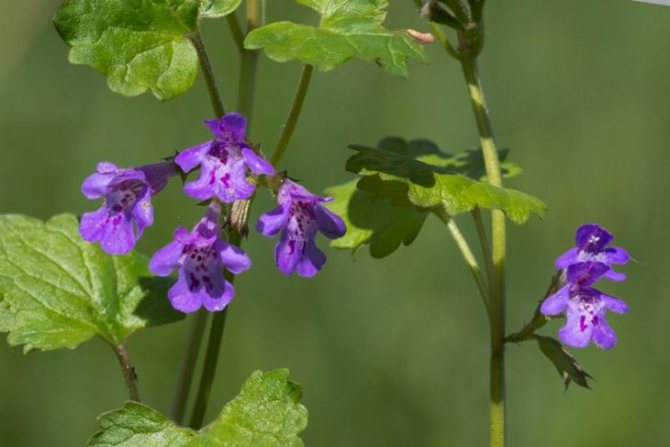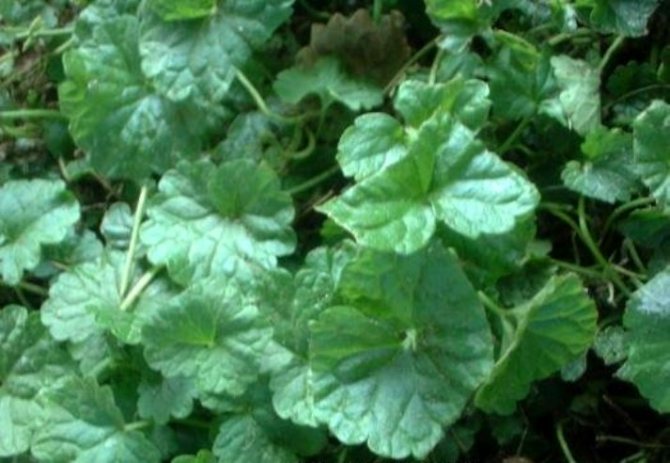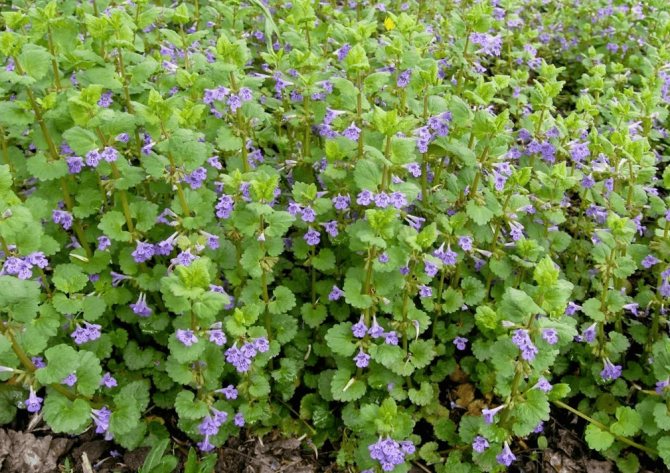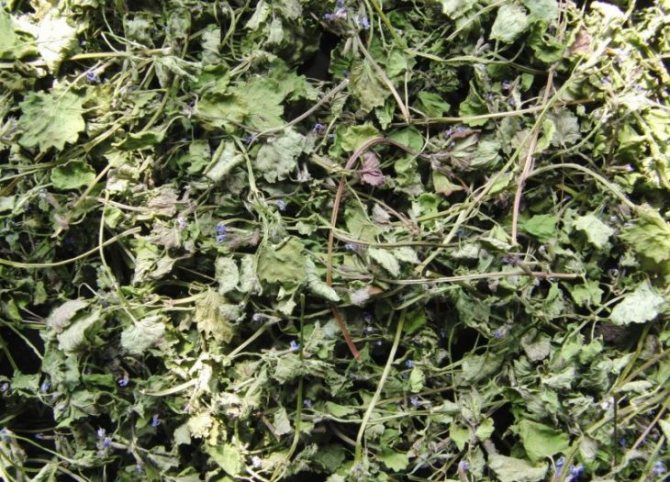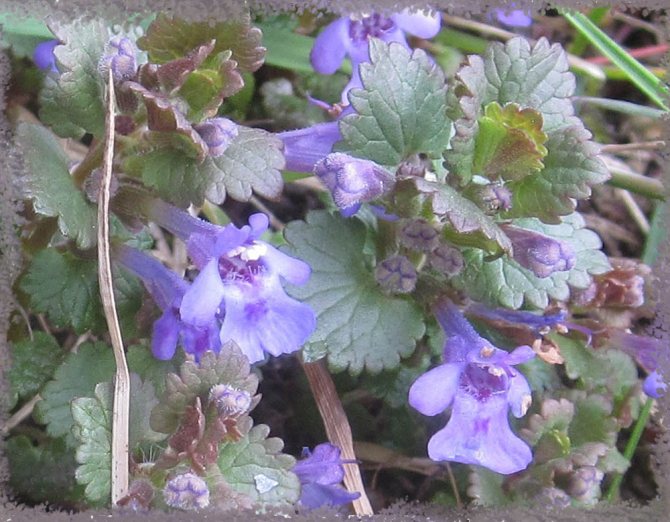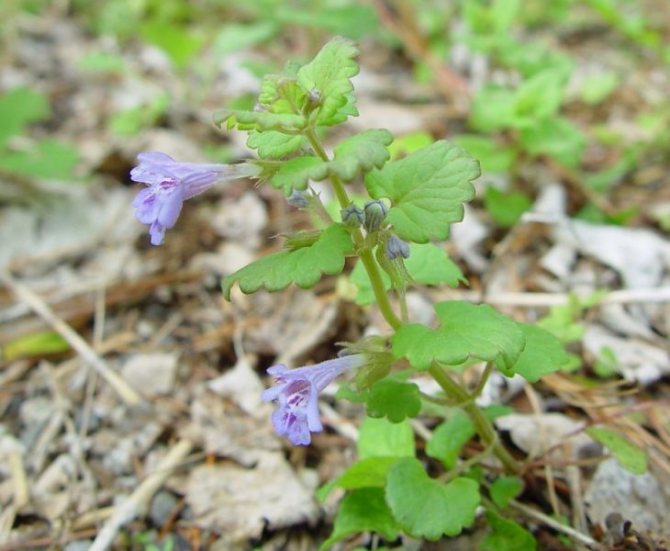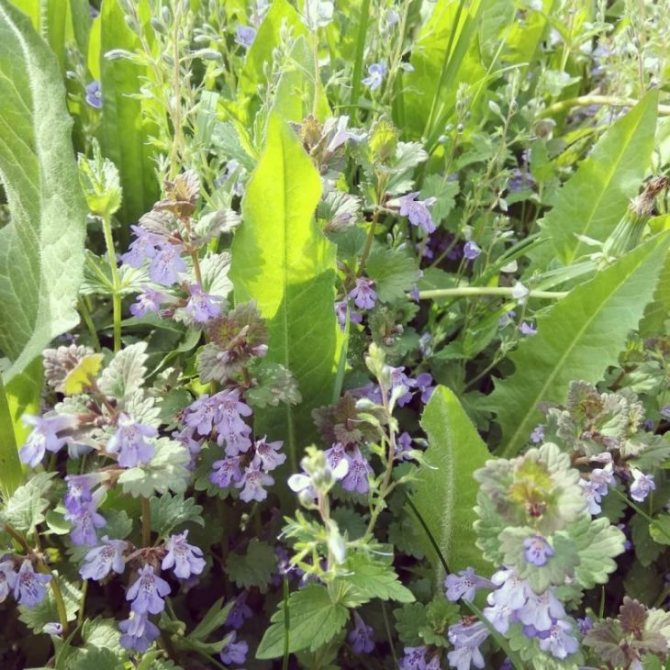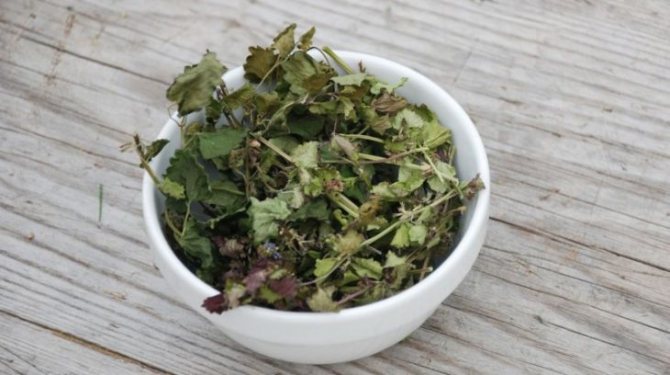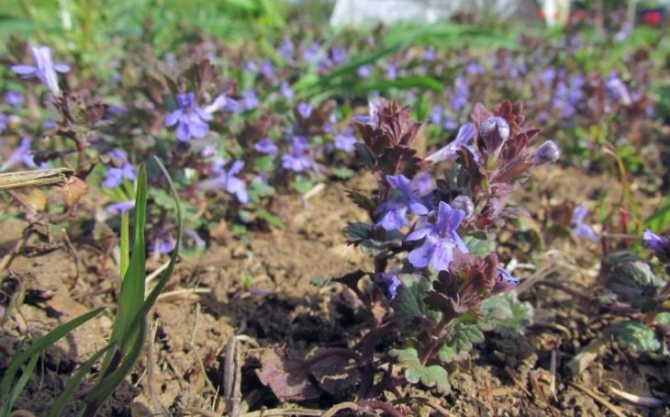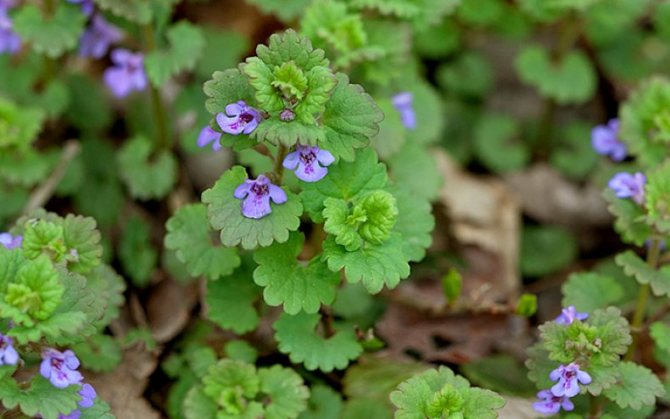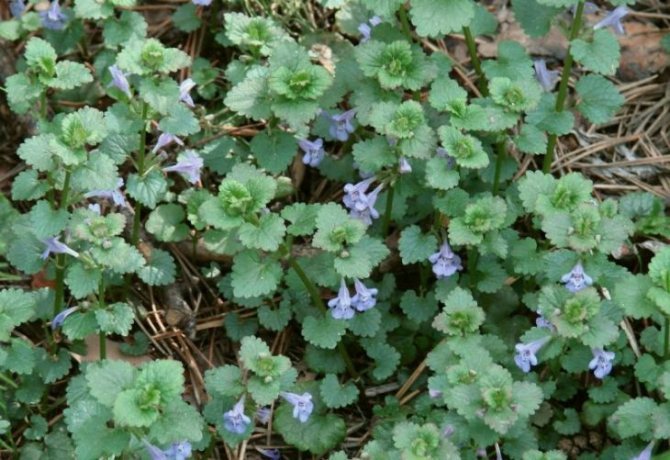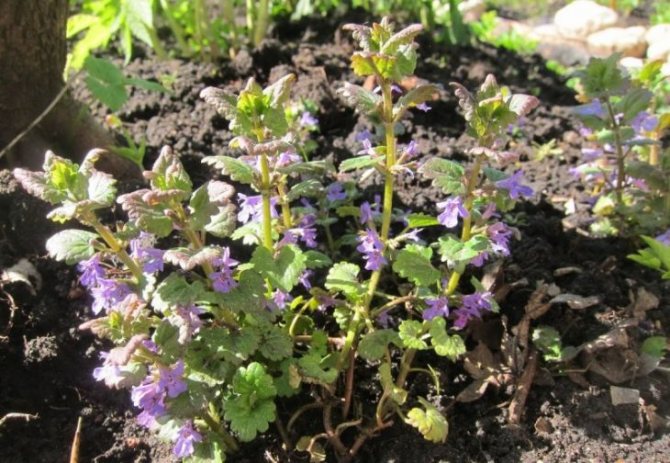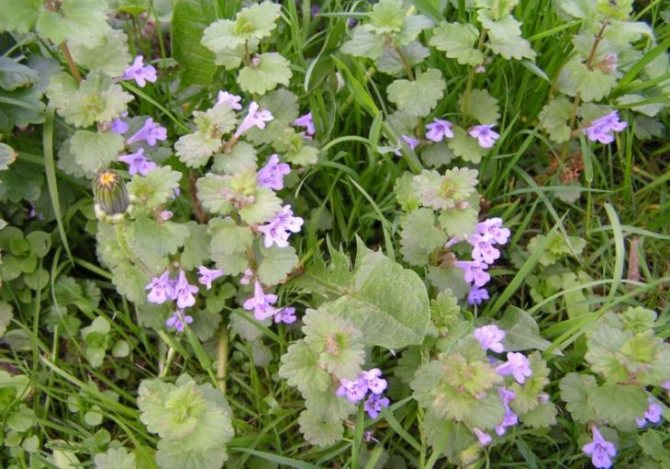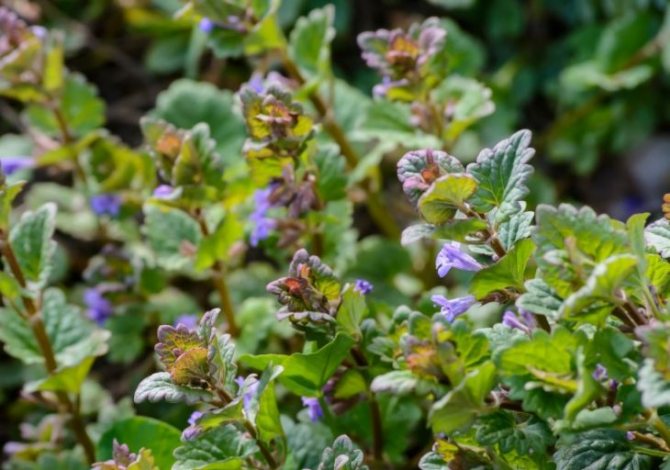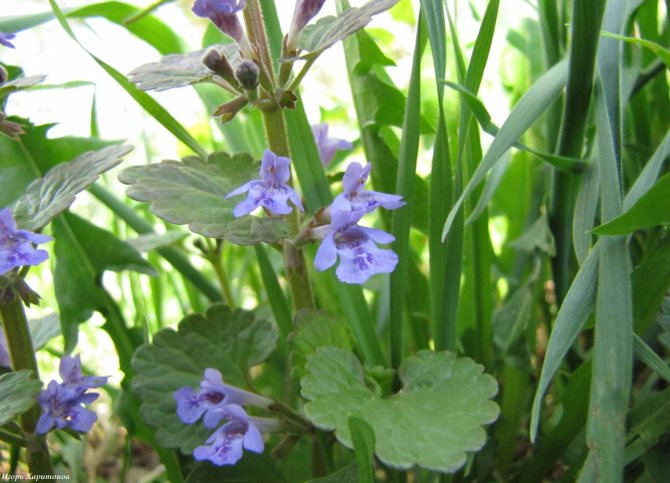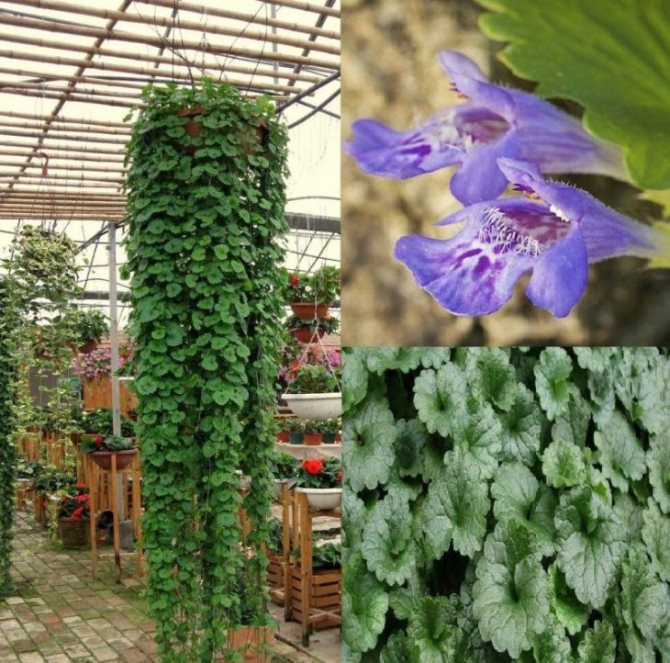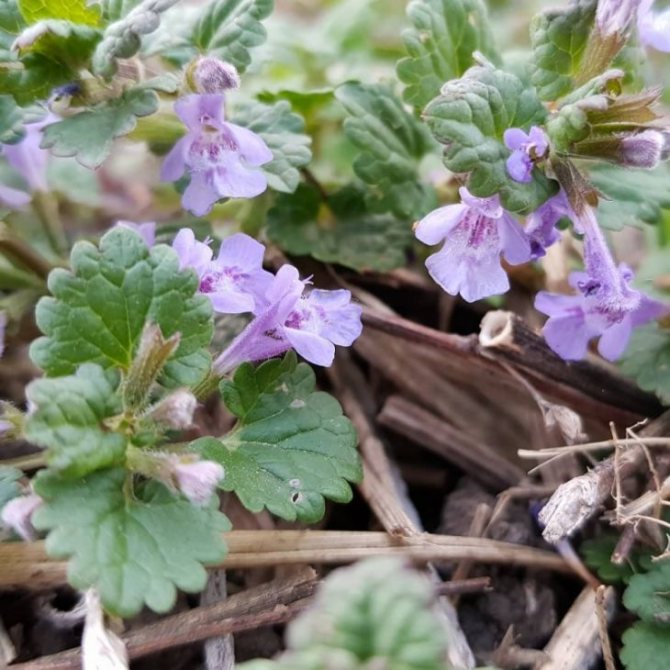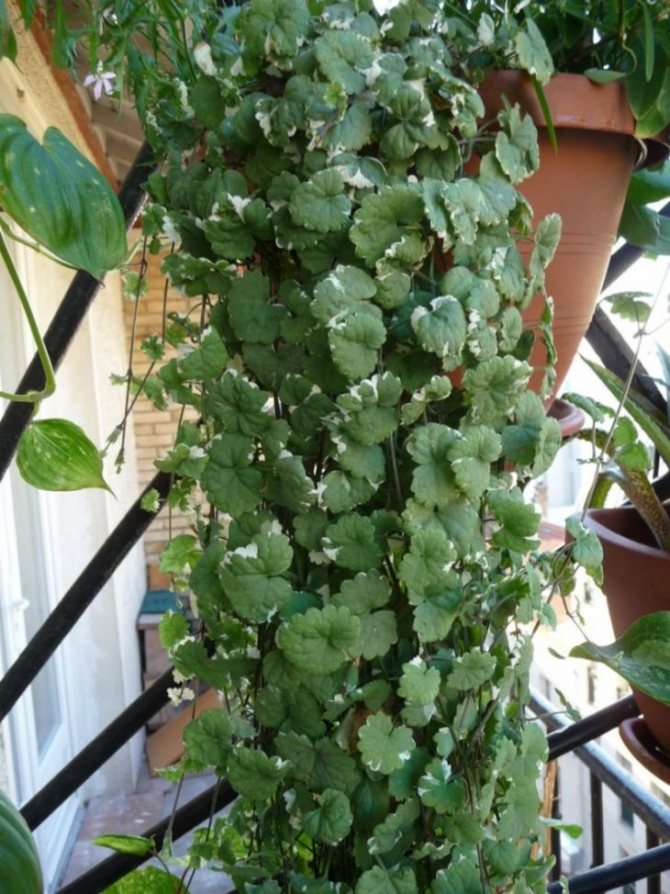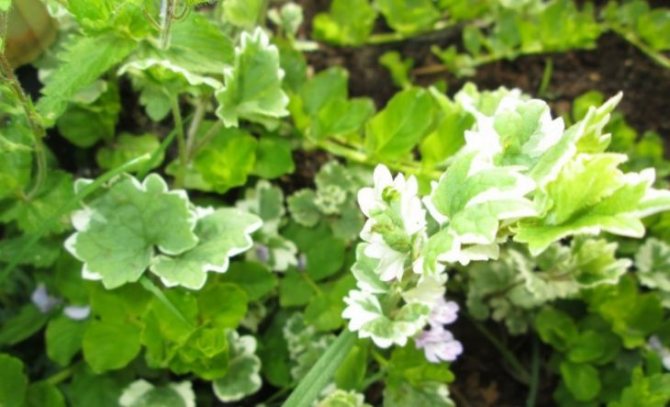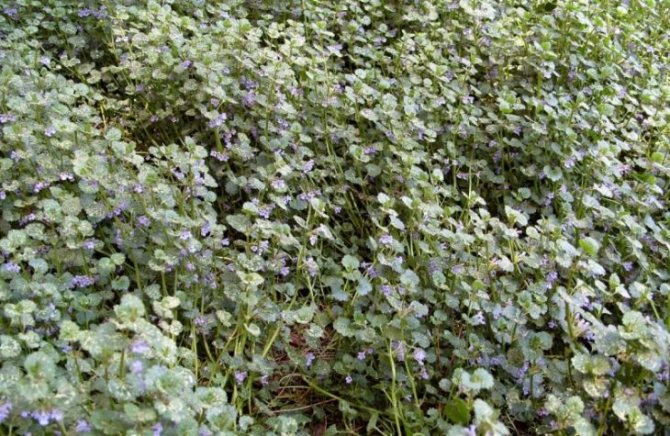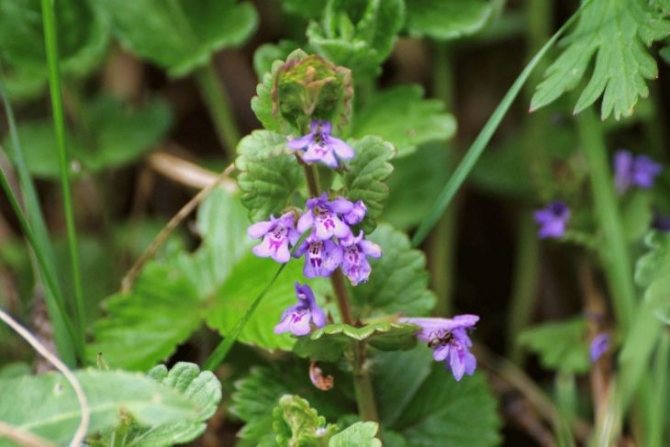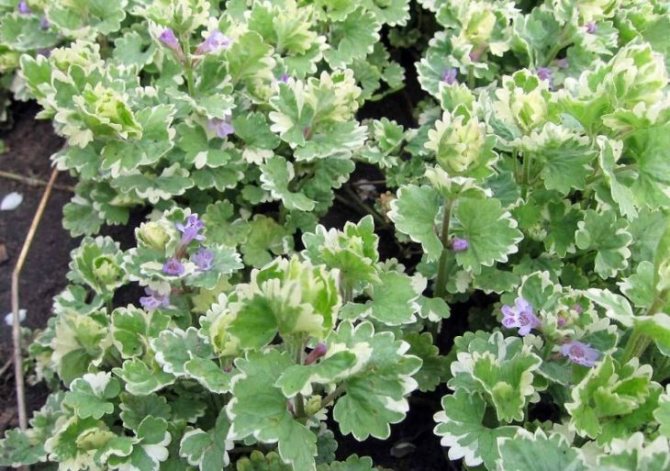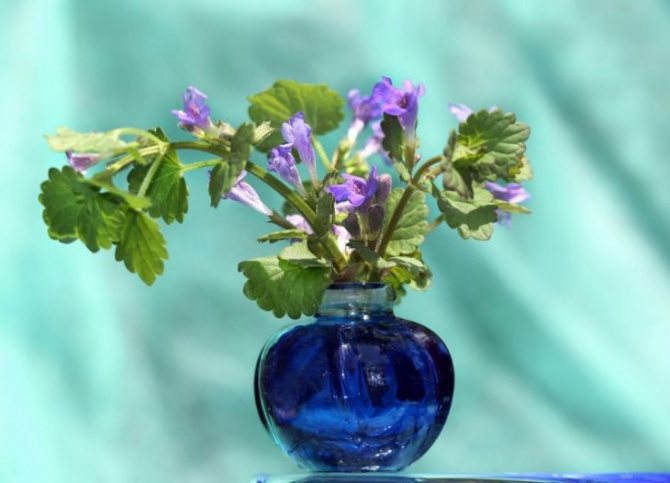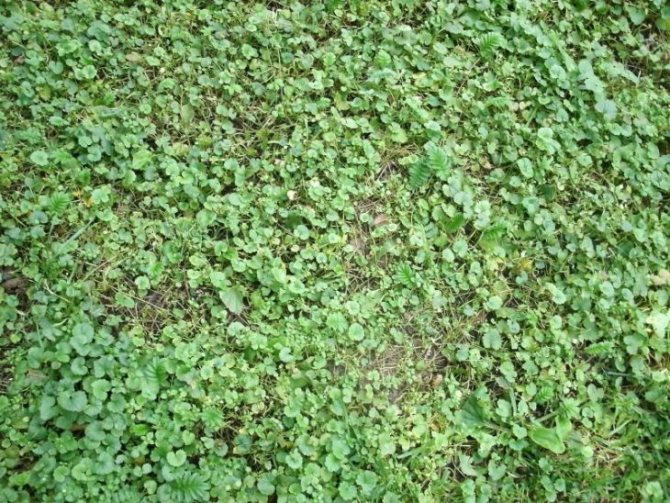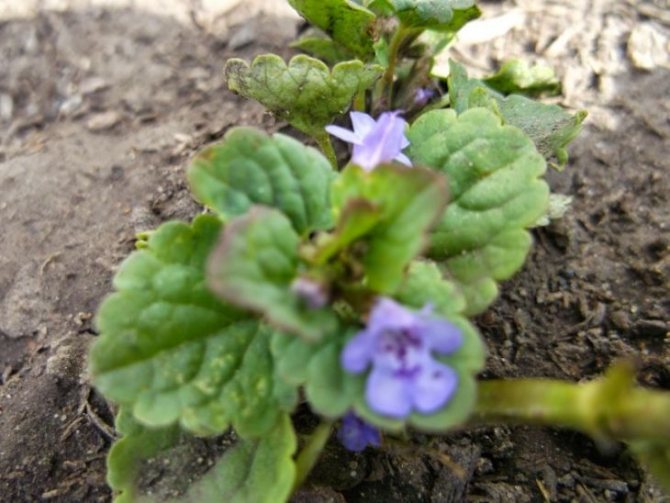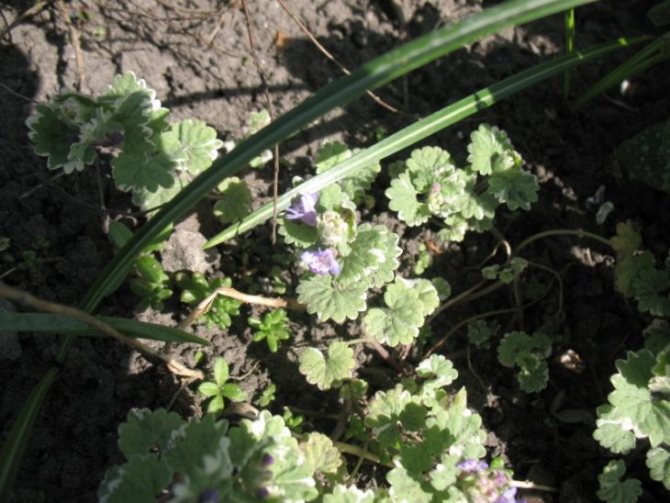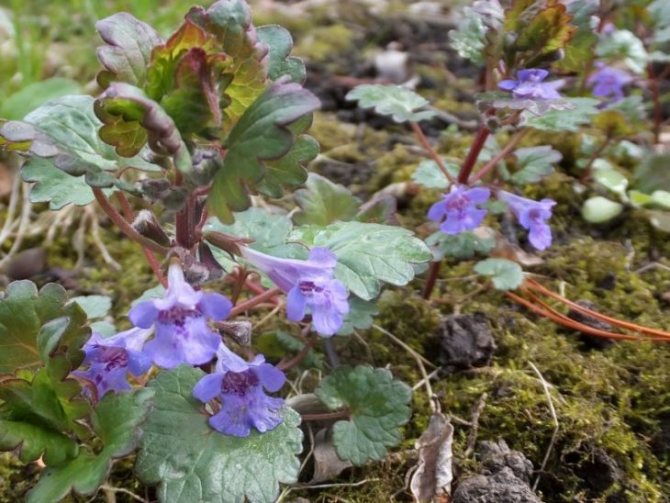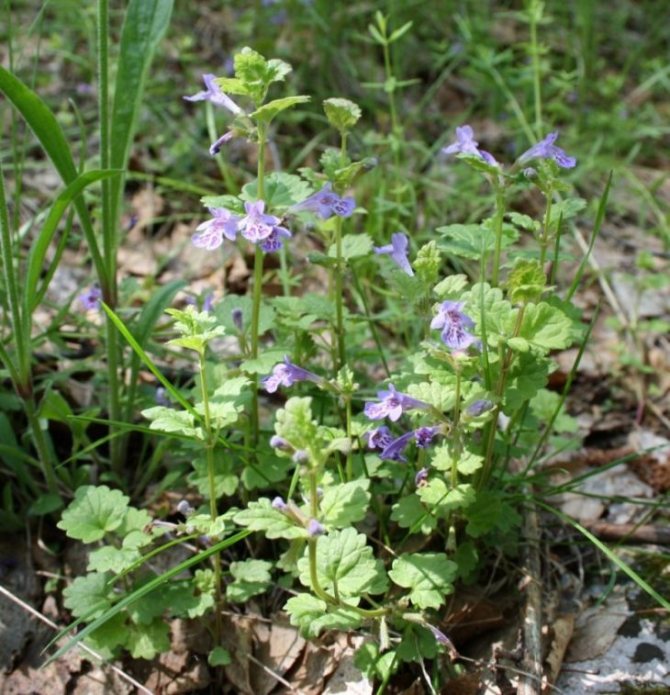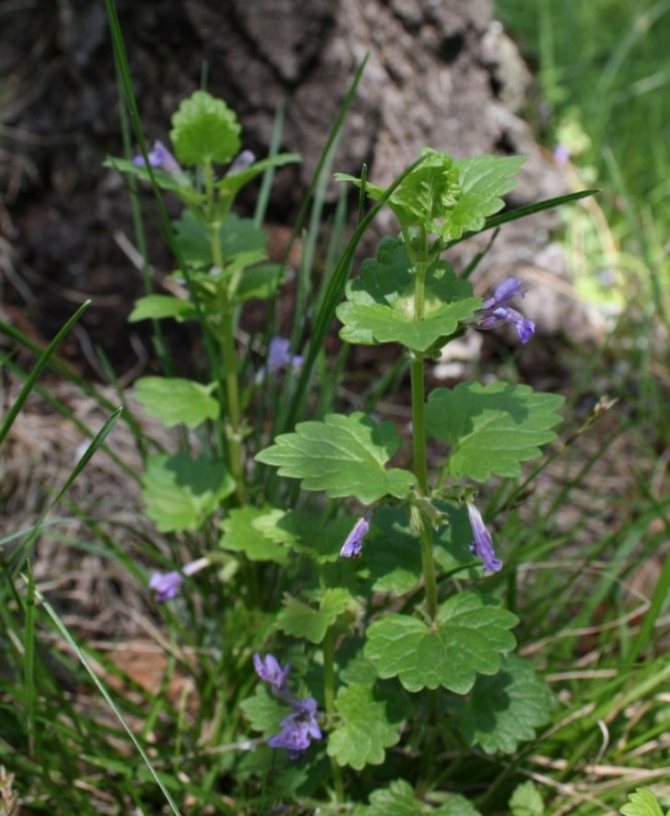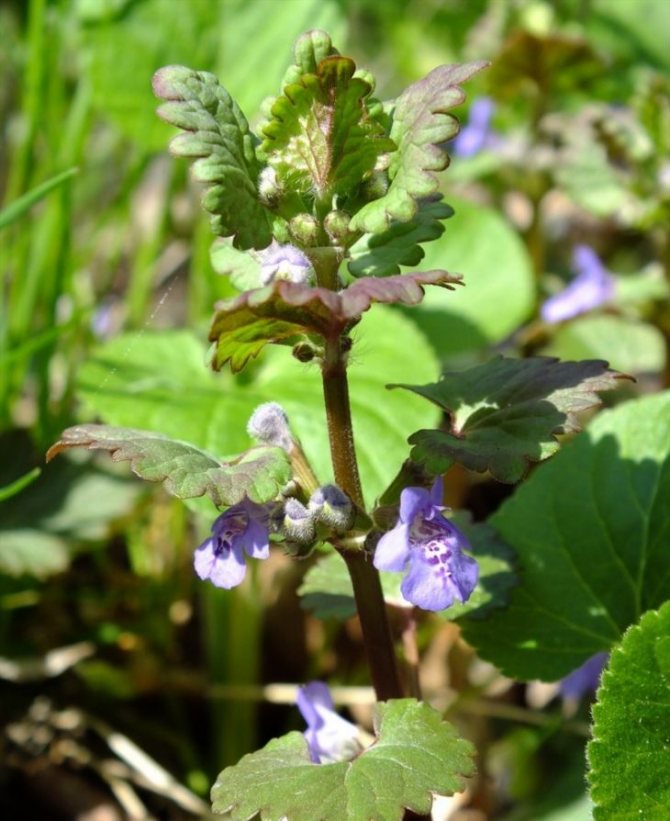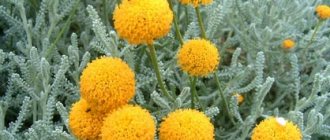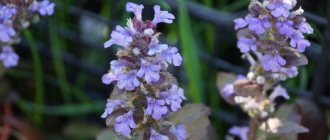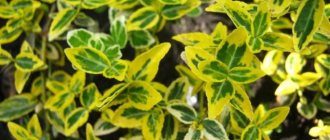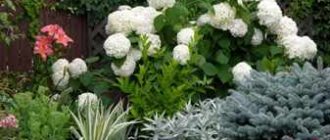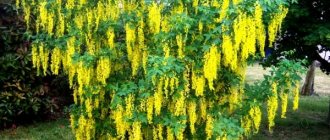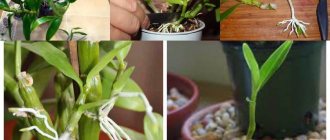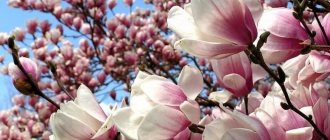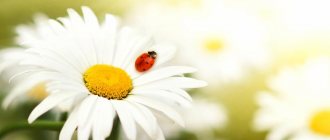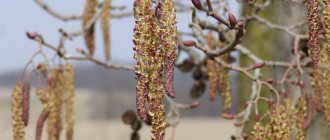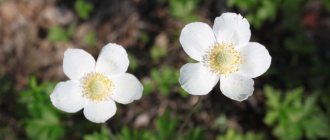Ivy budra is an evergreen crop that has been growing for many years. She has a stem creeping along the ground, strongly branching and quickly rooting. The stem has four edges. The leaves are small, cross-opposite. This means that two leaves grow from one node: one directed upward and the other downward. Budra belongs to the Yasnotkov family, like mint, lemon balm. K. Linnaeus, an outstanding Swedish scientist, writes that the name "budra" comes from the word from Ancient Greece, which means "field mint".
Budru is used in folk medicine, in official medicine it is used in Germany and France. To make medicinal tea, it is harvested during flowering, in May - June, the top of the plant with flowers is cut with a knife. Then they are assembled into bundles and hung to dry. Drying should take place at a temperature of + 40 ° C.
Ivy budra
Ivy budra
Ivy budra (creeping) is a poisonous herbaceous perennial of the Lipocystaceous family (Yasnotkovye).
Has the following popular nicknames:
- dog mint;
- catnip (although it is more often called catnip, another species of this family);
- blues;
- rams.
Description
Creeping stems, from 15 to 50 cm, sometimes slightly pubescent, often glabrous. Ivy bud is named because its leaves resemble ivy leaves: they look like hearts with zigzag edges. Small gramophone flowers of blue, blue, violet shades: the middle is darker. The lower lip of this two-lipped flower is longer than the upper one. Blooms from April to June. A characteristic feature of the plant is a strong odor reminiscent of mint. People perceive this smell as unpleasant, although budra is used to flavor drinks, it is added to broths for flavor. Dogmint stays green for a very long time, until snow falls. In the spring, when the snow melts, these leaves turn purple.
Livestock does not eat budra, but bees love this plant very much, and honey from budra is very useful. This moisture-loving plant grows in meadows and forests of the European part of Russia, in the Caucasus, in Siberia. Ivy budra was considered a talisman. She was planted at home to protect the family from the evil eye and disease.
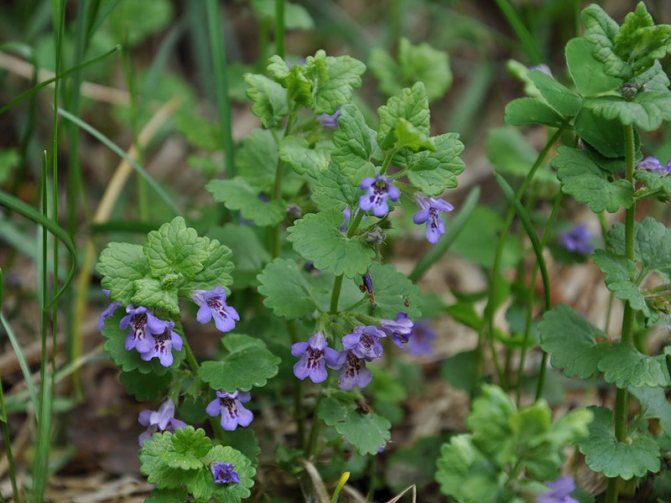
Ivy budra bushes photo
Structure
The herbal part contains a rich set of active ingredients:
- bitterness;
- choline;
- gum;
- methionine (amino acid);
- steroids;
- alkaloids;
- tannins;
- flavonoids;
- essential oil.
Healing properties
In Russia, the plant does not have medicinal status, although in Germany and France it is used by official medicine. People sometimes refer to Budra as "the forty-year-old", that is, a medicine for 40 ailments.
Boudra is shown:
- with oncology;
- burns;
- disruption of the thyroid gland (diffuse goiter);
- benign tumors;
- ENT diseases;
- diseases of the urinary system;
- diseases of the gastrointestinal tract;
- against worms;
- as an external agent - for rashes, boils, psoriasis;
- as a gargle - for sore throat and mouth.
Laboratory studies have confirmed the effectiveness of Budra in the fight against cancer: it inhibits the growth of cancer cells and the formation of metastases. Boudra is used in official pharmaceuticals as a perfume for medicines.
Medicinal use
For the preparation of potions, the aboveground part of the budra, harvested during flowering, is used. The delicate upper part of the plant is cut with scissors and dried at room temperature. Dry raw materials are bitter and burn. You need to store it in paper bags, glass or tin cans for no more than a year.
Recipes
There are a lot of recipes for folk healers with dog mint. Here are just a few of them:
Infusion of Budra:
1 tsp raw materials are poured with 250 ml of hot water, insisted for an hour under the lid.
For coughs, acute respiratory infections, chronic sinusitis, kidney stones, gout, take a quarter of a glass three times a day half an hour before meals. With holicystitis, the course of admission is 3 weeks, they drink a third of a glass three times a day.
The infusion is effective externally as an eye lotion for conjunctivitis, as a compress for a fracture (accelerates bone regeneration). Douching with infusion is used for leucorrhoea and gonorrhea (twice a day). Infusion rinse sore throat and mouth with inflammation of the gums.
Budra juice against liver cancer
bronchi, throat, lungs and cirrhosis of the liver are taken 10-15 drops three times a day 30 minutes before meals. To preserve it, add 25 ml of alcohol for every 100 ml of juice, store it in a glass bottle in the refrigerator.
Against liver cancer: 10 drops of alcoholic budra juice are added to the infusion of Budra according to the standard recipe. Take a third of a glass three times a day 30 minutes before meals.
It is interesting to use Budra juice for migraines:
3 drops of juice are instilled into each nostril. This is a great option if the migraine is accompanied by vomiting and there is no way to swallow the pain pill.
Bath for gout:
4 tablespoons are poured into a liter of boiling water. raw materials, cook for 15 minutes. Top up with 1 liter of water and
take a bath until it cools down.
Contraindications
Since creeping budra is highly toxic, an overdose will cause a flu-like
condition, strong salivation, violation of the rhythm of the heartbeat. It is contraindicated in pregnant and lactating women, with hypertension and increased blood clotting, severe liver damage, gastritis with low acidity.
Even Hippocrates believed that cleansing the body was the key to a long healthy life for every person. Moreover, it is necessary to get rid of not only toxins, but also toxins, which are full of modern industrial cities.
Harmful substances tend to constantly accumulate in tissues and organs, so they need to be removed regularly. Ivy budra grass in therapeutic doses will help remove unnecessary substances from the body, and at the same time heal other organs.
Where to find and how to properly harvest Budra
Outwardly, this medicinal plant resembles a hybrid of mint and ivy. The aroma will not allow it to be confused with other herbs - strong, but unpleasant. You can find thickets of Budra in places with high humidity: near rivers, lakes, on forest edges, next to thickets of bushes, etc. The chances of finding a useful perennial are high among residents of the European part of Russia, the Caucasus, the Far East and Western Siberia.
From April to June, Budra produces small flowers. They are painted in blue, blue, purple shades. During the flowering period, you need to deal with the preparation of medicinal raw materials. The stems should be cut at a height of about 10 cm from ground level. Then they must be dried in any of their ways:
- in a shady place outside;
- in a warm ventilated room;
- in the dryer, at t + 30 ... 35C.
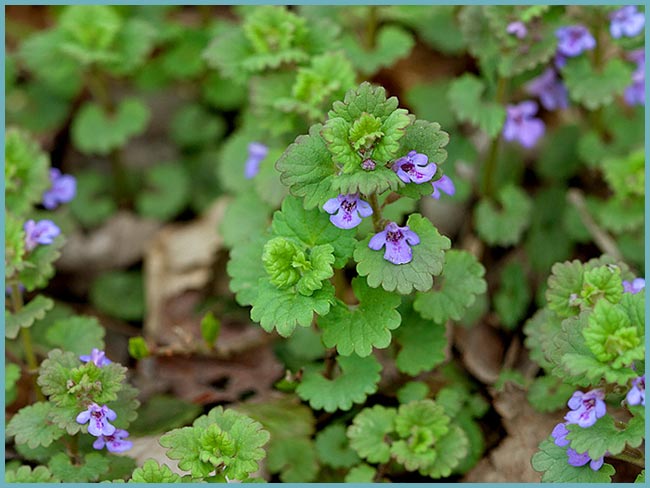

To be used for medicinal purposes, the bud must be properly dried.
At the same time, the grass is laid out in a layer not thicker than 5 cm, so as not to delay the drying process. With prolonged drying, the quality of the bud will decrease.
Advice. In a tightly closed container, raw materials are stored for no longer than a year. Keep it at room temperature and moderate humidity (up to 70%).
Structure
The ivy buddra belongs to the large family of the Ivory plants, which includes almost 8 thousand plant species. Other well-known herbs belong to this family: basil, sage, lemon balm, thyme. But, unlike relatives, ivy budra is poisonous, so it is not recommended to take it yourself. And her smell is not very pleasant, vaguely reminiscent of mint. The plant got its name from the resemblance to ivy.
This short plant with velvet leaves grows on river banks, on wastelands and darkened slopes, in thickets of bushes and along roadsides. Thanks to creeping branched stems and small roots, budra covers the entire space with a solid carpet. It is distributed in Eastern Europe, Central Asia, China, Mongolia, North America and the Far East.
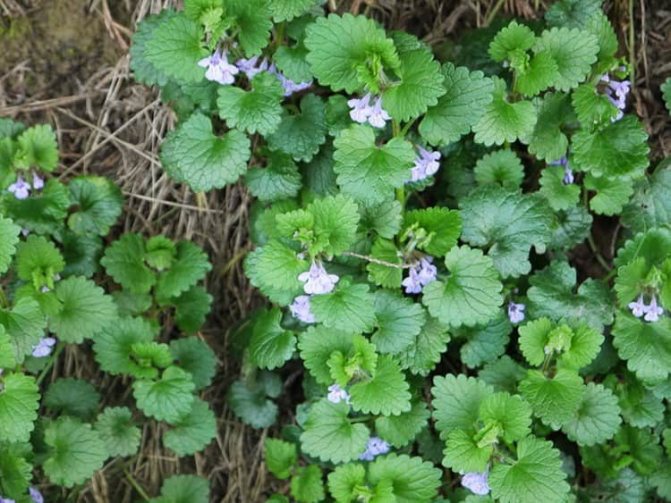

Ivy buddra contains:
- saponins;
- tannins;
- bitter substances;
- organic acids (tartaric, acetic);
- minerals (potassium, molybdenum, zinc, manganese);
- carotene;
- ascorbic acid (vitamin C);
- the vitamin-like substance choline;
- amino acids (methionine, cysteine);
- essential oils;
- alkaloids.
Ivy budra has other popular names: dog mint, catnip, molehill.
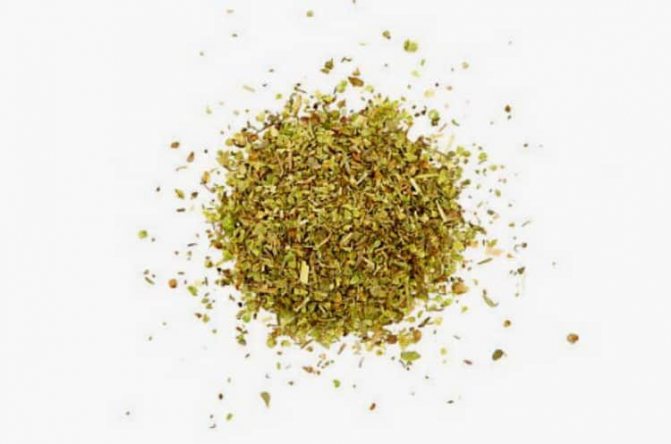

Ivy plants
Ivy plants grow along roadsides, along river banks, in fields and meadows. In winter, their foliage is green. It is rounded or heart-shaped, the edges of the foliage are crenate. Leaves grow back, then age, and then they are replaced by younger ones. It grows from the end of April until the blooming of the buds, and then begins to grow after the flowering ends and almost until frost. Flowers are two-lipped, 2-6 pcs., Are located in the axils of the foliage.
Description of ivy ampelous budra
Where does monstera grow in nature - the birthplace of the plant
Such a heap has a stem up to 60–70 cm long. On the stem there are branches that are directed upward and stand straight. When the culture begins to bloom from May to July, the buds are light azure or pale purple in color. Further, the fruits ripen, which disintegrate into four smooth nuts.
For your information! Flowers and foliage emit a not very pleasant smell, so the plant has another name - "wild mint" or "dog mint".
Where grows
Culture is growing in all regions of Russia, but it is not in some areas beyond the Urals. Most of all, grass likes river floodplains and fertile alluvial soils.
Budra ampelous can grow in a flowerpot, flowerpots, baskets.
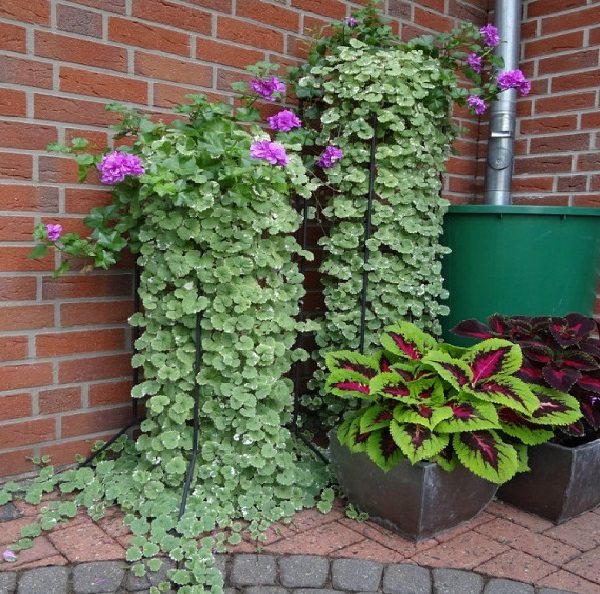

Budra in pots
For planting as soil, mix 1 part peat and 1 part sand. A cutting is first planted in a flowerpot, covered with a film and placed in a warm room with good, but diffused lighting, that is, not in direct sunlight. They constantly monitor the moisture content of the earth. A flowerpot or pots are placed in a permanent place, covered with a film. If the air temperature is below 10 ° C, then the container is brought from the street into the apartment.
Useful properties of ivy budra
Only the ground part of the plant has healing properties - stems, leaves and flowers. In pharmacies, medicinal budra is sold in the form of a dry herbal collection, as part of herbal teas. Decoctions and tinctures are made from ivy-shaped medicinal budra.
The healing properties of some components of the plant:
- Saponins have anti-sclerotic and venotonic effects, liquefy phlegm when coughing up and participate in the synthesis of the hormone progesterone.
- Bitter substances help improve appetite and digestion. When ingested, bitter substances irritate the mucous membranes and taste buds. As a result, the production of gastric juice becomes more intense than usual, and the secretion of the pancreas is improved. Long-term therapeutic use of bitter substances can bring the nervous system back to normal.
- Tartaric acid is widespread in the plant kingdom.With a balanced diet, its reserves in the body are regularly replenished, but with stress, increased radiation background, and intestinal upset, the need for tartaric acid greatly increases. Acid protects body cells from harmful external influences, dilates blood vessels, tones the heart muscle.
- Choline belongs to the B vitamins. It is a constituent of an antioxidant, without which the liver, brain, and nervous system cannot function. Holit reduces cholesterol levels, thereby protecting blood vessels from clogging.
- Zincand its compounds are necessary for the body for the normal daily work of the pituitary gland, and the glands: prostate and pancreas. It regulates and accelerates fat burning and prevents the formation of fat cells in the liver.
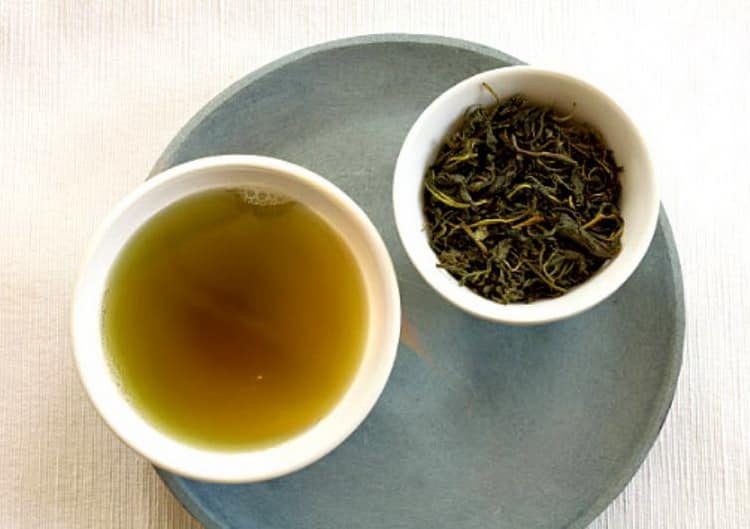

Heavy metals and toxins enter the body in different ways. They accumulate in food, settle in water bodies and are present in the air. Heavy metal salts are excreted through the lungs and the digestive system.
It is possible to remove them without medication, by establishing proper nutrition. The liver and kidneys participate in cleansing the body more than other organs. Ivy budra improves digestion and pancreas, normalizes the function of the bronchi and lungs, and accelerates metabolism. So its use is directly related to the cleansing of all organs and blood vessels from heavy metal salts.
The well-known “birch sap” will help everyone to wash and cleanse the kidneys. Even children know about its medicinal properties.
Ivy budra has other medicinal properties, and is used as:
- hemostatic;
- diuretic;
- choleretic;
- expectorant;
- tonic;
- anthelmintic;
- antipyretic and diaphoretic;
- pain reliever.
Preparations based on the ivy-shaped healing budra can reduce the drug load on the body, but they should not be used uncontrollably or prescribed to oneself. With all the impressive list of useful properties, ivy budra is not so harmless.


Mother Nature has endowed every herb with medicinal properties. Even the usual weed — the body — is capable of replacing half of the usual medicines.
The benefits of the plant and contraindications for use
Due to its rich chemical composition, Budra has a diuretic and choleretic effect, helps to treat skin diseases, serves as an anti-inflammatory, expectorant, anthelmintic and analgesic agent, and is an antiseptic. The benefits of this herb are tangible for such ailments:
- gastritis, ulcer, stomach catarrh;
- ARI, pneumonia, bronchitis, tonsillitis;
- thrombophlebitis;
- headache and toothache;
- bronchial asthma;
- mastopathy;
- gout;
- psoriasis, eczema, scabies, etc.
Budra improves appetite and metabolism. Their compresses contribute to the restoration of bone tissue, therefore they are used for fractures. The effectiveness of the universal plant in liver cancer and cirrhosis has been proven.
Attention! Budra is a poisonous herb, so you need to use it very carefully.
Doctors always warn about the dangers of self-medication, so prescribing a decoction or tincture without a qualified recommendation is not the best option. However, if you decide to try alternative medicine recipes yourself, keep in mind that Budra is not for everyone.
Contraindications:
- increased blood clotting;
- renal failure;
- decreased secretion of gastric juice;
- liver disease;
- pregnancy and lactation;
- age up to 3 years.
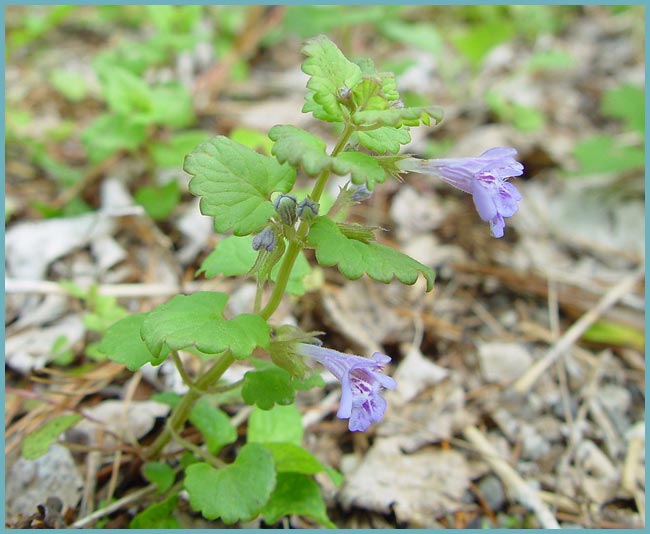

When using Budra, the dosage must be strictly observed
Application in traditional medicine
In official medicine, ivy budra preparations are recognized only in Germany and France. They are not officially used in our country, but this herb has been used in alternative methods of treatment for a long time. Its medicinal properties were well known to healers and healers in Europe and Asia.
Infusion and tea from budra are prescribed for:
- lung diseases: laryngitis, bronchitis, pleurisy, bronchial asthma, prolonged cough;
- bowel diseases: colitis, intestinal colic, prolonged diarrhea;
- liver diseases and cholelithiasis;
- colds and chronic rhinitis.
Poultices and herbal compresses are used for:
- furunculosis;
- skin rashes;
- gout;
- non-healing ulcers and wounds;
- conjunctivitis and lacrimation.


Additionally:
- in case of fractures (to accelerate tissue healing), healers are advised to take baths with tincture of this medicinal herb;
- gruel from crushed fresh leaves is applied to abscesses, thereby reducing pain and speeding up wound cleansing;
- with freshly squeezed juice, plants wash festering wounds, wrap ulcers and burns;
- medicinal tincture is useful to gargle the throat and mouth with stomatitis or sore throat;
- tincture in low concentrations is used for douching and enemas for hemorrhoids.
Benefits of Budra: photo
Contraindications
Ivy budra is a poisonous plant, so, in addition to its medicinal properties, it is necessary to familiarize yourself with contraindications. It is allowed to take it after consulting a doctor and not violate the dosage and regimen. But if you tune in to therapy before the result is obtained and do not interrupt the prescribed course, the efforts will bring the expected results.
It is strongly not recommended to take any preparations of ivy budra with:
- pregnancy and breastfeeding;
- allergic reactions and drug intolerance;
- hypertension;
- severe liver pathologies;
- low acidity of gastric juice;
- increased blood density.
Overdose
In case of an overdose of the drug, it is possible to get intoxication, which is manifested by strong sweating and palpitations, profuse salivation and respiratory failure. In these cases, the patient needs to take one of the following means:
- a large amount of activated carbon;
- strong laxative;
- calcium chloride.
And be sure to call an ambulance.


Toxic properties of the plant
Dogmint contains an essential oil that is physiologically active in moderate to large amounts. Presumably, this oil is responsible for the plant's toxicity. In addition, although in small quantities, there is a natural toxic substance called pulegon.
In several European countries, weeds were often considered poisonous to horses. Symptoms of toxicity include sweating, salivation, difficulty breathing, dilated pupils, and sometimes signs of pulmonary edema.
Apparently, ivy budra is toxic only if consumed in large quantities fresh or in hay (it is horses that are affected).
People using dog mint or planning to use it for therapeutic purposes should exercise great caution.
Pregnant women are contraindicated to use this herb or formulations prepared with it, since it has abortogenic (miscarriage) properties.
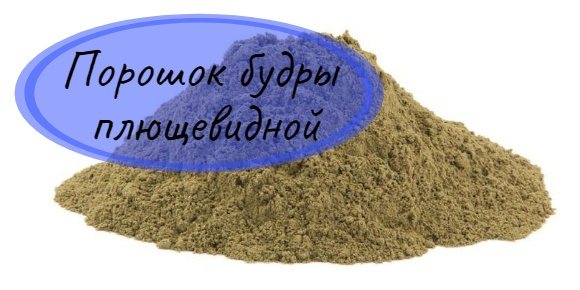

The use of budra is also prohibited for patients with epilepsy. Large doses can irritate the stomach, intestines, and kidneys and cause severe liver damage.
People with a known allergy or sensitivity to bite or other members of the Lamiaceae family, including mint, rosemary, basil, oregano, thyme, and lavender, should avoid using budra therapeutically.
Essential oil of Budra should not be taken internally, it is only for topical use on the skin.
Helpful information
- For bronchitis and severe coughing, a tincture is prepared: steam a third of a tablespoon of chopped grass with a glass of boiling water and wait until it cools completely. Strain the tincture and take 2 tablespoons no later than an hour before meals.
- For scabies, a vinegar tincture is prepared: pour 15 g of grass with half a glass of vinegar and leave in the refrigerator for a week.Rub the affected areas no more than once every 3-4 days.
- For toothache, a decoction is made: pour 2 teaspoons of the herb with a glass of water and boil over a minimum heat for 5-7 minutes. Strain and rinse your mouth, but never swallow. This broth is used to prevent periodontal disease.
- A decoction (1 tablespoon of herb per 200 ml of water) is added to the mixture for inhalation. Inhalation of vapors clears the airways, relieves a cold.
- For the treatment of dermatitis, boils, ulcers, with inflammation of the joints, crushed grass is poured with boiling water to the state of gruel. Warm gruel is wrapped in several layers of gauze and bandages are made. The bandage needs to be changed several times a day.
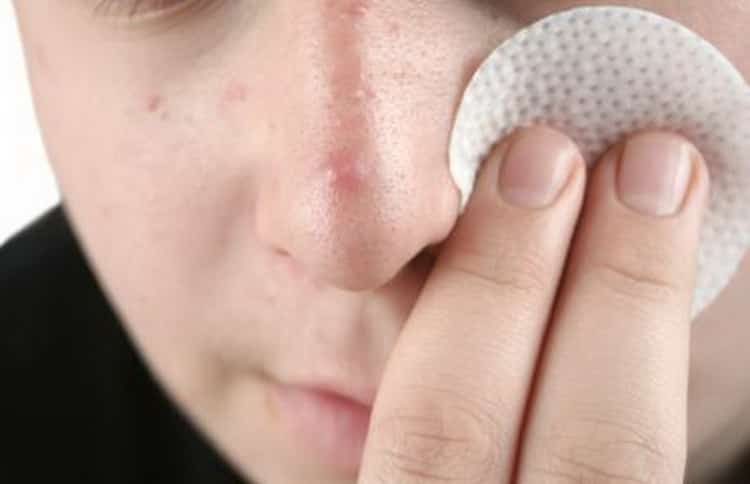

Ivy budra is an abundant spring-summer honey plant. Fragrant golden honey has no pronounced medicinal properties, but it helps to replenish the supply of essential substances in the body in the winter. Besides, honey is very tasty and aromatic.
This ornamental plant has long been used to decorate large lawns. In the photo, ivy budra looks like a beautiful carpet, it grows well in shaded places, so it is planted under trees. Small blue or purple flowers only improve the appearance of the decorative coating.
Hosts who like to make homemade herbal infusions often use a burda to flavor drinks. Young greens are sometimes used as a spice for marinating meat.
The immortelle has many uses in cooking, aromatherapy, cosmetology and healing alternative medicine.
Other historical uses of Budra
The stalks of dog mint were once woven into wreaths for the dead. Sometimes this herb was given to horses as an anthelmintic.
Many grazing animals avoid Budra because of its bitter taste, but bees, on the other hand, readily visit its flowers. Several old English recipes recommend adding young spring leaves to homemade jams, soups, oatmeal and vegetable dishes.
It used to be sold as a garden plant for seedlings in hanging baskets. The shredded plant contains a lot of iron. Because of this, it was often added to compost.
The Swiss believed that if you mix fragrant rue, boudra and burdock, it gave sharp eyesight and indicated the presence of witches.
Once upon a time, on the streets of London, they sold ground buddha for making medicinal tea. There were even specialized trading platforms - it was so popular.
There used to be an excellent cooling drink known as Gill Tea. To do this, they insisted about 30 g of grass in 0.5 liters of boiling water, sweetened with honey, sugar or licorice. They drank such a drink only chilled, one glass three or four times a day.
Boudra was a favorite medicine for poor people because it helped quickly get rid of a prolonged cough. Tea was also drunk for kidney disease, indigestion, nervousness and headache, and was sometimes used as a lotion for tired and sore eyes.
Now the plant is used by modern herbalists as a remedy for tumors, kidney diseases, abscesses, eye problems and more.
How to collect and store
Budra is harvested during flowering. Intact stems with fresh leaves and flowers are cut with scissors or a sickle. Dried, like all medicinal herbs, in well-ventilated areas.
A properly dried medicinal herb can be stored for 1 year.
Ivy budra has many popular "nicknames". Share in the comments, maybe you know other names of this plant and healing recipes with it.
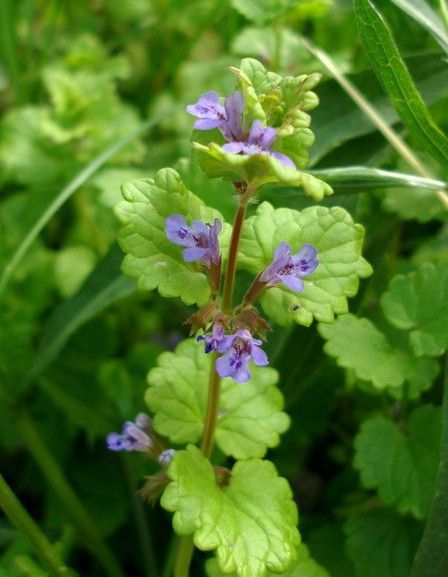

The plant ivy budra (Glechoma hetieracea (hederacea) L.) belongs to the labiate family - Labiatae. The plant is popularly called dog mint or catnip.
Budra herb - Hederae terrestris herba.
origin of name
The word "Glechoma" comes from the Greek word "glehon", which means - mint or thyme. "Hederaceae" in Latin means "ivy-like", which most likely indicates the shape of the leaves, or external resemblance to weeds.
Boudra was first named by Glechoma hederacea by Karl Linnaeus (1741 - 1778) in the book Species Plantarum, published in 1753. But in 1843, the German botanist George Bentham (1800-1884), in his monumental work on the Labiatae (Lamb family), Labiatarum Genera et Species, reclassified this species as Nepeta glechoma.
The word "Nepeta" in translation means "ivy from Nepeta", which is probably named after the Etruscan city of Nepeta.
In 1842, the Italian botanist Vittore Benedetto Antonio Trevisan (1818 - 1897) described the same species as Nepeta hederacea. However, all these names soon became simple synonyms.
Today, most botanists agree with Linnaeus's original name Glechoma hederacea, although the alternative name Nepeta hederacea is occasionally still used.
Features:
The characteristic of the appearance is as follows: it is a perennial herbaceous plant. Shoots can grow up to 50 cm. Flowers grow on these terrestrial shoots. In addition, ivy-leaved budra has creeping vegetative shoots located on the surface of the earth. Roots grow from their nodes, fixing themselves in the ground.
Leaves are attached with petioles, opposite, with short hairs.
The flowers have corollas of blue-violet color, they are located in the axillary rings. The plant blooms from April to the last days of the summer months.
Fruits are elongated and oval in shape, appear after flowering. These are brown nuts.
Habitat: the plant can be found in vegetable gardens, near roads, in fields, in wastelands, as well as in gardens. Ivy budra prefers fertile lands with high humidity. The plant spread to Asia, Europe, North America. The plant can also be seen in Russia, in all regions.
Grass from the head
If you still do not know what the ivy budra looks like, the photo will put everything in its place. Small patterned leaves, delicate violet-blue inflorescences that resemble both an orchid and pansies, and long shoots. Budra looks equally beautiful on the wall of a country house, and in a flowerpot on a gazebo, and on endless Siberian fields ...
Unlike most medicinal herbs, the names of which are full of ancient Chinese and ancient Persian treatises, budra is an exclusively European herb. Old Norse legends and tales about the Torah also mention her. Allegedly, the god of thunder was married to the goddess of fertility Siv, the only one who could humble his violent temper. The secret lies in the fragrant bud, from which Siv brewed a soothing potion.
But today, traditional medicine does not say anything about the sedative properties of grass, although it heals headaches excellently. Maybe the stern Thor just often had a headache?
Chemical composition
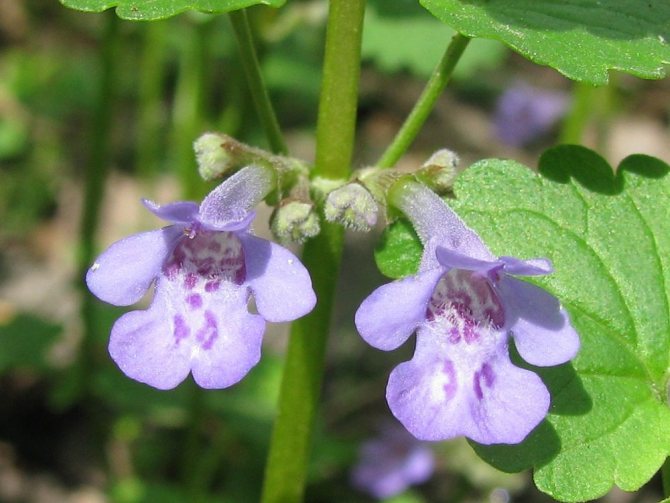

This medicinal plant has numerous beneficial properties that are quite actively used in folk medicine. Description of the nutrients that make up the catnip: saponins, bitter and tannins, organic acids, resins, fatty acids, iridoids, triterpenoids, vitamins (including vitamin C), alkaloids, flavonoids, phenol carboxylic acids, some essential oil.
From forty ailment
"Onions from seven ailments" - we hear this saying from mothers and grandmothers since childhood. But the legendary European weed has seriously pulled ahead in this relay - it is from forty ailment! And although it is difficult to count and confirm whether the budra herb is so good, its medicinal properties are truly amazing.
The wall contains acids, essential oils and tannins, traditional for medicinal herbs, as well as vitamin C, choline, carotene and trace elements, including the most useful zinc.
Dog mint is an excellent antiseptic, natural diuretic and choleretic. Broths from budra relieve inflammation and pain, stop infection, work as an expectorant, stimulate metabolism and tone up.And many doctors recommend to their patients magpie for liver diseases, because this herb has strong hepatoprotective properties. Let's say more - budra is even included in many well-known dietary supplements to improve liver function!
If ivy-shaped budra grows on your site, its medicinal properties will be useful in the treatment of such diseases:
- pathological enlargement of the liver, cirrhosis;
- inflammation of the gastrointestinal tract;
- bronchitis and pneumonia;
- bronchial asthma;
- inflammation of the bladder (cystitis);
- kidney and bladder stones;
- colds and tonsillitis;
- edema caused by impaired renal function;
- mastopathy;
- wounds, burns, boils, acne;
- headaches and migraines.
Aromatic dog mint tea helps to recover from a serious illness, tones up, improves appetite and normalizes the stomach and intestines. And if you work in hazardous industries or just live in a gas-polluted metropolis, a cup of broth from budra will help support the liver and reduce the level of hazardous substances and heavy metals in the blood.
Application and useful properties:
Budru is used in medicine due to the presence of essential oils to improve the smell and taste of medicines. The plant is prescribed in the event that the patient suffers from cough with phlegm, indigestion, accompanied by diarrhea, jaundice, loss of appetite, kidney disease, liver, bile ducts. As an external agent, budru is used for rinsing the throat and treating wounds. In homeopathy, the herb is used for hemorrhoids. The medicinal properties of the ground part of the plant also make it possible to widely use it for the preparation of a variety of remedies for bronchitis, diseases of the bladder, tracheitis, as an analgesic for nephrolithiasis, for the discharge of sand, for postpartum pain, for cramps of arms and legs. This plant is a healing, anti-inflammatory, expectorant.
Wisconsin nightmare
Budra was appreciated not only in Europe, but also on our Russian soil. Dog mint (yes, not everything is just for cats to rejoice!), A wall (here it is, vertical gardening!), Ivy, ram and magpie. All these are our Russian names for Budra. And in England they call her the sneaking Charlie - and you immediately feel the energetic and purposeful nature of the weed.
The ivy budra is famous not only for its names - its medicinal properties and contraindications so captivated the Europeans that they decided to share it with the recently discovered America. And there was an embarrassment: Budra liked it incredibly in the States. Humidity, shade, lots of space - such an environment is ideal for ivy, and it was simply impossible to destroy it.
Today, in the states of Wisconsin, Kentucky and Nebraska, the sneaky Charlie is hated with fierce hatred and considered a malicious weed. But at the same time, dog mint is included in the pharmacopoeia of the United States, as well as France, China, Bulgaria. That is, in these countries, its medicinal properties were officially recognized, in contrast to Russia, where the magpie is only in the recipes of traditional medicine.
Contraindications
However, Budra may be contraindicated as it is poisonous. All medications with this plant should be taken with caution in order to prevent overdose.
Collection and procurement Blooming dog mint should be harvested in the spring, rinsed to remove soil, and air dried.
Healing recipes
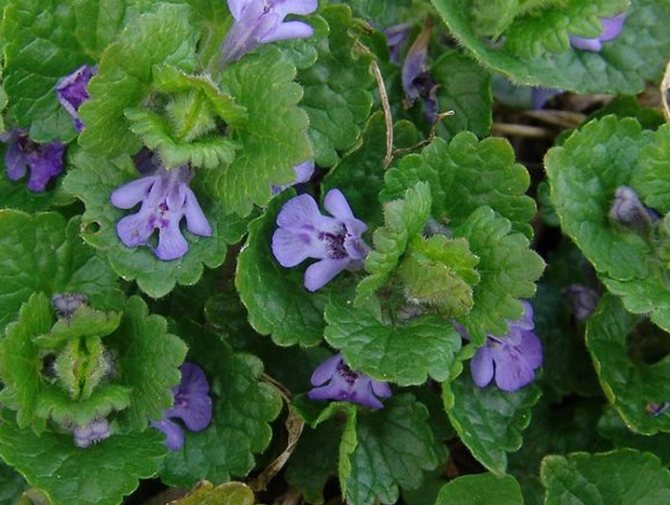

Budra is often recommended to be consumed in spring along with the leaves of birch, nettle, yarrow, watercress, daisy, and bush. Lettuce has a slight irritant effect on the organs, which improves human health.
- To make medicinal tea from budra, you need to take 1/4 liter of hot water, add 1-2 tsp. plants, insist for five minutes. The patient is usually given one cup, and if it is required to undergo a course of treatment, then the patient is prepared for a cup of tea 2 times a day.
- Infusion recipe: you need to pour 1 tbsp. boiling water 1 tsp. dry herbs (pre-grind). Boil over low heat for several minutes, insist from half an hour to an hour, filter and consume 1/3 cup three times a day.
- The plant powder is recommended to be used 3-4 times a day, one pinch. Tincture - 15 drops 3 times a day.
- The broth a day is taken four times, 2-3 tbsp. spoons. Cooking ratio: 1:40.
- Fresh leaves of the plant are applied to the affected areas on the skin. Before that, they should be pounded. In winter, you can take dry leaves and steam them before applying.
- You can make vinegar tincture of budra. It is used to treat scabies and is rubbed on sore spots twice a day.
Fresh plant juice is more effective for treatment than tincture and decoction. Baths and compresses with budra are recommended for scabies, acne, skin rashes, wounds and purulent ulcers. With chronic rhinitis, inhalations are effective.
Boudra in cooking
Besides medicinal purposes, dog mint is also used for culinary purposes. The delicate leaves of this herb can be eaten raw or after cooking.
Budra leaves have an astringent taste (dry sensation), which is why they are added to salads for a sophisticated flavor. Alternatively, young leaves are prepared in the same way as spinach, used as a flavoring agent, added to soups, stews, omelets and other dishes.
Herbal tea is brewed from fresh or dried leaves. Often the leaves of this herb are mixed with vervain. Boudre was added to beer in the same way as hops to make the product more tasty, to improve its taste, while maintaining the best properties.
In fact, this herb was the most commonly used herb to flavor beer before hops were introduced.
Budra leaves have a bitter taste. In many countries, they are used as green salad and for flavoring.
Dogmint was previously used in the cheese making process to replace animal rennet.
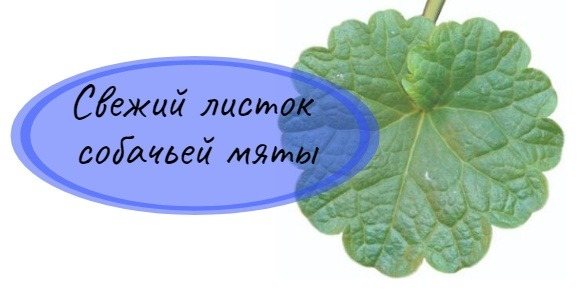

Brewing with ivy bud
People have been brewing beer and ale from grains for millennia. Even the ancient Egyptians, Greeks, Romans and other civilizations prepared this festive drink.
German brewers were the first to discover the value of hops in brewing. They began to grow it for this very purpose as early as the 8th century. But until hops were introduced to other countries, only wild herbs were used in the brewing process for aromatization.
Until the time of Henry VIII, Boudra was the most popular brewing herb in England. For hundreds of years, dog mint remained the preferred flavor and cleanser in home brewing, as hops were considered hazardous to health by many until the 17th century.
Conditions for landing
If you have chosen a budra for growing in your garden, you need to adhere to several conditions. She prefers intense diffused light, but grows well in shaded areas. It is advisable that during the day it is illuminated by the sun for a longer time.
This plant does not have any special requirements for the quality of the soil; it takes root well on most soils. The grass is thermophilic, so it is better to start planting when the ground warms up and the outside temperature reaches + 10 ° C, but it will grow and develop at a temperature of about + 20 ° C.
As a groundcover, it can be used to decorate around the trunks of garden trees. It will take root well, filling the voids between conifers and shrubs.
You will probably be interested in reading about such ground cover perennials as evergreen Iberis, sedum, periwinkle, primrose, saxifrage, carnation, loosestrife, rejuvenated.
It is also suitable for creating lawns and lawns, it looks organically in a flower bed, where at the beginning of summer it may even prevail until the time of flowering begins.
General information about the plant
The plant belongs to the genus Budra, which is part of the Lamb family. This herbaceous perennial is often found in temperate European zones. For the first time, the plant appeared in certain states of North America, where they were actively trying to get rid of it like a weed, but it stubbornly worked its way towards further spread. This grass mainly grows on forest edges, in thickets, near water bodies. As indicated in the Plantarium catalog, ivy budra is found throughout Russia, especially a lot of it:
- in the European part;
- in Siberia;
- in the Caucasus;
- in the regions of the Far North;
- in the Far East region.
The name of ivy budra arose from the similarity of leaves and stems with ivy. Scientifically, the exact name of the plant sounds like ivy mint. The plant has a lot in common with its namesake. Its name varies depending on where it grows:
- Cat / dog mint - because of its strong smell, the herb is loved by these pets;
- Catnip - indicates the addiction of cats to the plant;
- Sorokaneduzhnaya herb - gives an idea of the extensive medicinal properties;
- Podbirukha;
- Dushmyanka;
- Molewort.
From the description of ivy budra, it is clear that this flower does not have bright external characteristics. Its distinctive feature is creeping roots, creeping along the ground and causing a lot of inconvenience to summer residents who care for the beauty of their site. The maximum length of the tetrahedral stem is 50 cm, on it there are petioles with small rounded leaves. For them and for the stem, insignificant down is characteristic. Two-lipped flowers are miniature due to the non-standard separation of the petals. The predominant color is violet or lilac. The flowering period lasts from April to August, when the fruits ripen, forming 4 nuts.
Many gardeners perceive dog mint only as a weed and strive to clear their lawn of it completely. This can be done manually with gloves due to the possible allergenicity of the grass, or with the help of special garden tools that can completely remove unruly roots. After that, you need to burn them to avoid the possible spread of seeds. As preventive measures, the following are suitable:
- mulching, wood shavings with a thickness of 5-7 cm work well;
- depriving the plant of all light sources, for this, the area with an ivy-shaped bud should be covered with a dense material that does not allow the sun to pass through, for reliability, putting a load on top, the grass will soon die.
Reproduction of budra
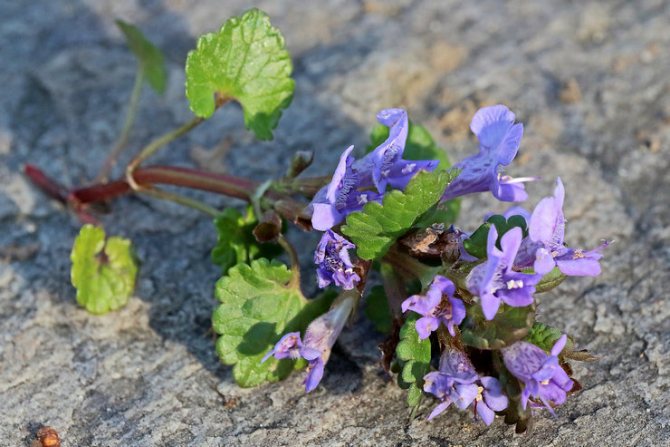

The most popular and effective way is to propagate budra with stem cuttings. Cut cuttings are placed for rooting in a vessel with water, root-forming solution or in moistened river sand. The first young roots will appear in about 3-5 days, after which the plant is ready for further growth in a separate flower pot or outdoors.
Budra is a fast-growing plant, and in the open air and on a large plot of land, its creeping stems, in contact with the ground, very quickly release new roots and take root. The culture is able to grow in a short time and cover all the space empty from plants. This must be taken into account if such a green covering on the site is not expected and is not planned.
Honey
Ivy buddra forms whole flower carpets during the period of mass flowering (late spring). However, bees do not visit its flowers very actively. A maximum of 19 kg of honey can be obtained from 1 hectare of plant thickets. The product is light yellow in color, very aromatic and tasty. Its main advantage is the content of many useful substances that are present in the plant. So, in honey budra there are:
- Trace elements (potassium, molybdenum, magnesium, zinc, titanium).
- Organic acids.
- Saponins.
- Flavonoids.
- Minerals
The use of this product helps to restore strength in the body, raises and strengthens the immune system, eliminates metabolic disorders, and is an excellent prophylactic against colds.
It can be eaten neat on a spoon every day. If you add crushed walnut kernels to this honey, you get an excellent remedy for restoring male potency.
You can also make drinks from budra honey. The easiest way is to dilute a spoonful of the product in a glass of water. To get a drink that works more effectively, you need to add lemon juice to it.
Budra honey cannot be consumed by people who have a tendency to allergic reactions and those who have contraindications to beekeeping products.
What substances are found in the plant
Ivy buddra in its leaves, stems and flowers contains:
- Tannins.
- Carotene.
- Bitterness.
- Saponins.
- Ascorbic acid.
- Amino acids.
- Resins.
- Choline.
- Essential oil.
- Iridoids.
- Alkaloids.
- Potassium.
- Manganese.
- Molybdenum.
- Zinc.
- Titanium.
- Acids (succinic, tartaric, feluric, sanapic, acetic).
- Phenolcarboxylic acids.
- Cysteine.
- Methionine.
Processes in the body
After the active substances of the plant enter the body, the following changes begin to occur:
- Strengthening lactation.
- Normalization of the gastrointestinal tract.
- The regeneration of damaged tissues and bones occurs at an accelerated rate.
- The existing foci of inflammation pass.
- The immune system begins its heightened work.
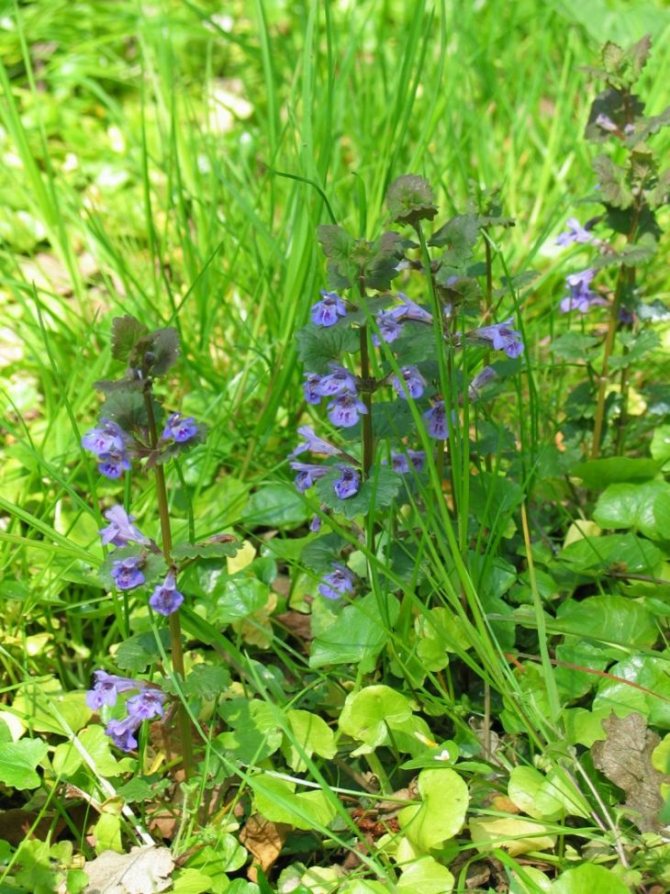

Landing in open ground
Since the plant is extremely thermophilic, it is planted in the garden when the soil warms up and a stable temperature of + 10 ° C is established outside. The ground cover begins to develop only actively at a temperature of + 20–22 ° C.
Planting budra is possible in two ways:
- Seeds. Take seed collected from old plants after flowering (in September). The seeds are pre-wrapped in a damp cloth for 3 days, which accelerates their germination. And you can also sort out non-viable seeds already at this stage. The sowing procedure is carried out in early spring or late autumn (in regions with warm winters). The seeds are evenly distributed over the surface of the soil, lightly pressed down by hand and sprinkled with earth. After the completion of the work, the crops are watered. For successful germination, watering will be required at least twice a week.
- Cuttings. A productive way that can be used throughout the summer. Cut off the tops of shoots 15–20 cm long, only without flowers. They are placed in water or dripped into a wet peat-sandy substrate (mixed in equal proportions) and wait for the appearance of the first roots. Then the cuttings are transplanted to a permanent place of growth in the garden.
Forest and field plants in the garden: ivy budra
There is something alluring about the grasses of the field, the flowers that bloom in the meadow every summer. We fill our gardens with gorgeous works of breeders, but you don't have to go far for beauty - it is nearby, just stretch out your hand ... And by the way, this beauty is also useful - most wild herbs have healing properties. No, I'm not at all against "cultural" flowers))) In my flower beds, they, of course, are in abundance. But for some time now I willingly combine them with representatives of forest and field flora, and have never been disappointed in my venture. Last summer I started a series of publications dedicated to wild plants. She told about yarrow, geraniums, cuff, Veronica oakravnaya, meadowsweet (meadowsweet) and her favorite - creeping tenacious. And this spring, she finally realized her old idea - she laid a flower garden consisting of fragrant garden and medicinal wild-growing herbs - such a small (for now!) Pharmaceutical garden.And this time I want to introduce you, friends, to a plant that I discovered for myself quite recently - ivy budra. Everyone must have seen her and even pulled her out of their beds and flower beds. There was already a question about budra on the site once, but it's worth returning to the conversation again. This creeping plant with a low (up to 25-30 cm) rising stem is found everywhere, and breeders have developed decorative varieties used as border and ampel crops. For its specific smell, budra was nicknamed dog mint, and for its ability to cure many diseases, they gave the name Sorokaneduzhnik. In fact, traditional medicine uses budra as a choleretic, diuretic, anti-inflammatory, expectorant and analgesic agent for diseases of the respiratory system, liver, gallbladder, various gastrointestinal diseases, as well as externally for skin rashes and furunculosis. Phytotherapist M.V. Gordeev talks about the wonderful properties and use of ivy budra, as well as how to properly collect and prepare medicinal raw materials:
In the garden, ivy budra does not require any special conditions or care. It grows wonderfully under trees and shrubs and can be used as a groundcover in flower gardens. It blooms very early, and this is already good - imagine: the snow has recently melted, the plants in the garden are just awakening, and the juicy green of the creeping shoots of Budra, strewn with purple flowers, pleases the eye. This year in our area it bloomed already in April! Then the grown flowers will hide the bud with their leaves, but they will not interfere with each other at all. In any case, I have it happily adjacent to rudbeckia, bells, cornflower, Veronica spikelet and other plants in flower beds. And of course, she settled on my pharmacy bed)) It is very easy to transplant budra: it forms many creeping shoots with young rosettes, which take root, barely touching the soil. The transplant is almost painless and absolutely undemanding. Actually, it is often not necessary to transplant it - just direct the shoots in the right direction. Do you grow wild herbs in your garden?
Description
Budra is an ornamental perennial plant. It is grown as a houseplant, outdoors and for decorating buildings and premises. The leaves are rounded with jagged edges, up to 2.5 cm in length, and have a scent. The flowers are small, pale blue or lilac shades, the flowering period is spring, May. Due to the fact that this flower tolerates pruning well, it can be given any shape, which is extremely important when decorating. The wrap looks very good when you use it to build lawns, because is a ground cover plant. The winter period tolerates well, hibernating under a layer of snow.
History
For the first time, grass became known from many medical textbooks in Europe. Many healers and botanists of that time actively used budra to treat people.
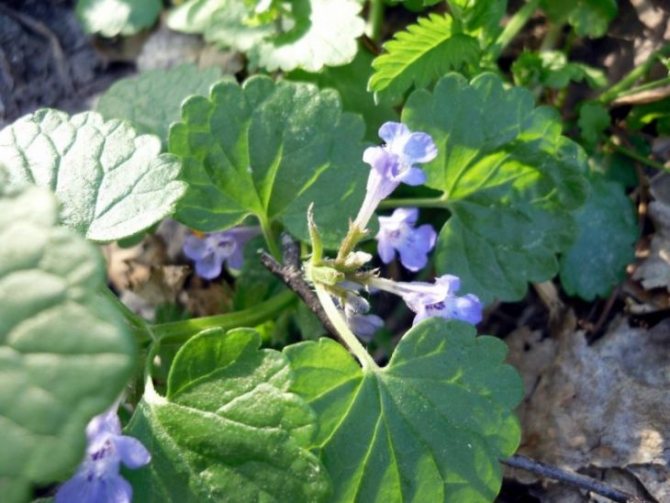

It is a known fact that with the help of this plant was cured long-term insomnia, which tormented one German farmer for 35 years.
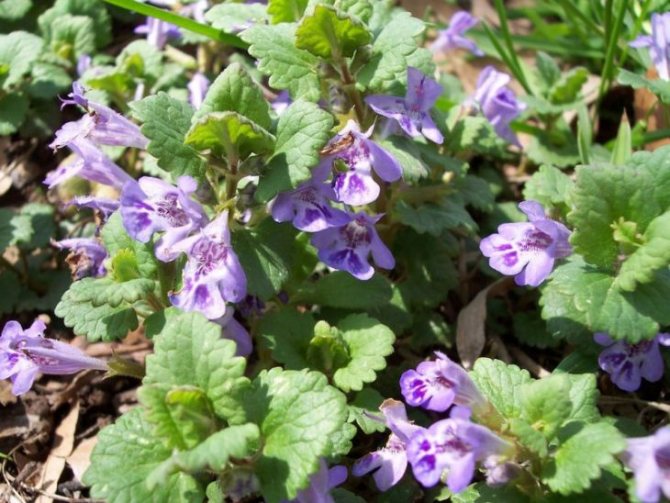

In cooking, it was cooked along with soup and served on the table to wealthy landowners, as well as those close to the royal families.
Growing problems
Most often, difficulties arise when growing at home. Such cases are rare in the garden. Possible options:
- With improper watering, the foliage turns yellow and falls off. This is due to the fact that the soil is waterlogged and the roots rot.
- If watering is insufficient, then spider mites or aphids settle on the bud. To get rid of them, you should use insecticides.
- Poor ventilation and large amounts of water can cause powdery mildew. To combat it, there are fungicidal agents.
Advantages and disadvantages
If ivy budra appeared on the site unplanned, then we can regard it as a weed. The plant is actively spreading, taking over neglected lawns. Getting rid of it can be difficult.
Nevertheless, the perennial has many advantages. Among them:
- High decorative effect. The beautiful leaves have a varied and interesting color (green, green-white, crimson).
- Nice mint-like scent.
- It is an excellent honey plant. In the presence of bees, honey can be obtained with high taste and healing qualities.
- Differs in resistance to phyto-diseases and unpretentiousness, perfect for rockeries. Growing is within the power of even a beginner, inexperienced gardener.
- Can be used for medical purposes.
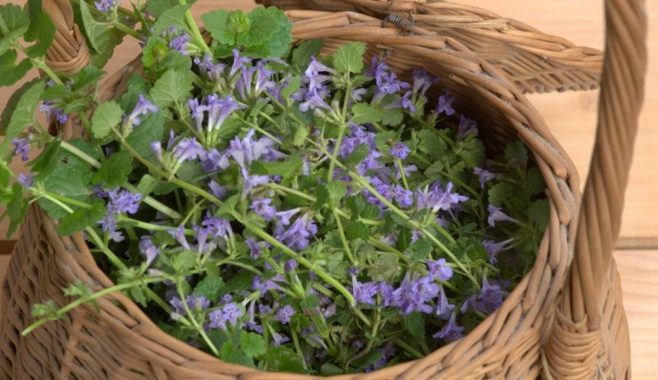

The culture is widely used by landscape designers to decorate summer cottages and country houses. It is suitable for decorating verandas, terraces, balconies. Looks good in flower arrangements and hanging flowerpots. Budra perfectly covers the soil, therefore it is an excellent option for decorating lawns and lawns. It can be used to decorate tree trunks, fill empty spaces between shrubs.
Who shouldn't use this herb
It has not only the healing properties of ivy budra. And she also has contraindications. It is important to remember that this plant is poisonous. Therefore, everyone, without exception, should use it carefully for culinary or therapeutic purposes.
Healers and doctors do not advise drinking drugs from Budra under the following conditions:
- Hypertensive crisis.
- Lactation period.
- Pregnancy.
- Reduced acidity.
- Lactation period.
- Blood clotting problems.
- Renal failure
- Individual intolerance.
- Allergy.
- Childhood.
Procurement process
Ivy budra has a growing season from spring to frost, but it is harvested for medicinal purposes, as a rule, during the period of its mass flowering. Only the upper (ground) parts of the plant are suitable. The rhizome is not used. You need to cut the stems in the morning or in the evening, when there is no dew on the leaves. Since this plant spreads on the ground, extraneous fragments are almost always collected (dry last year's stems, other small plants). Therefore, the collected raw materials must be carefully sorted out. After that, it is spread in the shade on paper or canvas. The layer should be no more than 3-4 cm. You can also bring the bud to readiness in the dryer. The temperature should be maintained no higher than 35 degrees. The finished raw material tastes very bitter and breaks easily. It is placed in glass jars and stored for no more than 12 months.
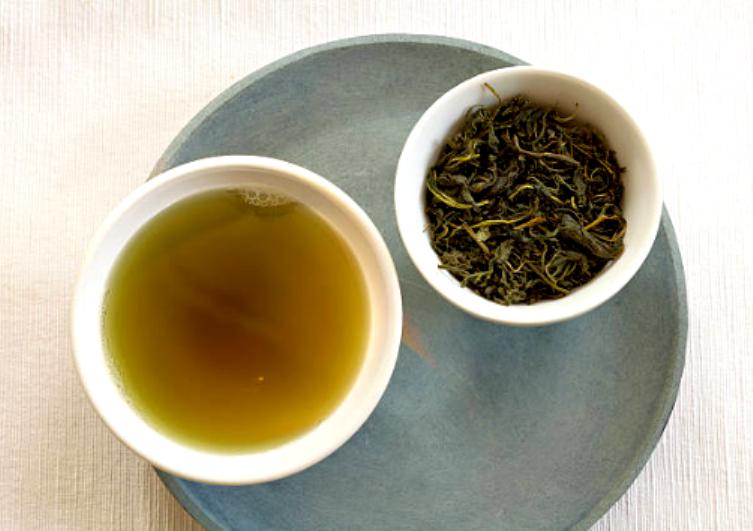

Growing budra
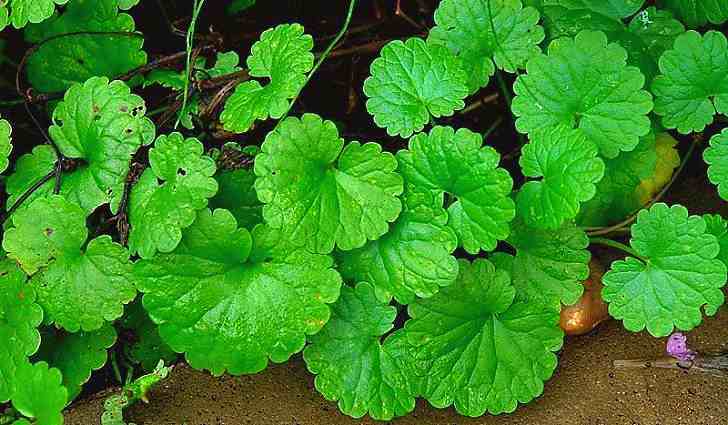

I do not recommend growing ivy buddha on your site, as it can be easily found and prepared in nature. In addition, recently on the lawns of personal plots of the Central non-black earth zone of Russia, ivy budra has become a malicious weed, and the owners cannot get rid of it.
Yes, this is such a controversial plant: on the one hand, there are a lot of useful properties, and on the other, a malicious weed, on which even herbicides have little effect. By the way, if you decide to "lime" it with chemicals, then it is better not, as all lawn grasses may die from exceeding the dosage.
There remains only a mechanical method of struggle - thorough, regular combing out with a rake and pulling out the rooted stems by hand.
Side effects
Contraindications for ivy budra are quite serious. If people do not pay attention to them or use drugs from the plant in high doses, the following reactions may occur:
- Abdominal pain.
- Increased sweating.
- Nausea.
- Profuse salivation.
- Vomiting.
- Pulmonary edema.
- Headache.
- Breathing disorder.
- Failure of heart rhythms.
If the listed symptoms appear, it is necessary to give the patient any adsorbent available in the house and call an ambulance.
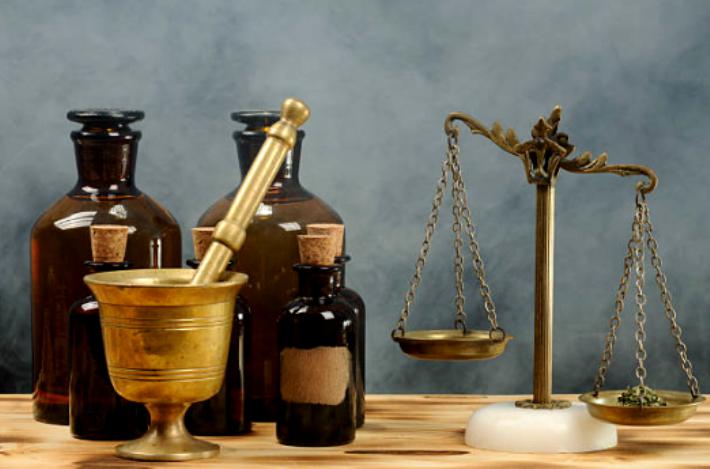

Testimonials
Not many people know about ivy bud as a medicinal plant. More often it is considered a malicious weed, therefore it is ruthlessly destroyed. Therefore, there are very few reviews on the network about its medicinal properties. Basically, this herb is used externally, as they are afraid that it is poisonous. The respondents report that the lotions from her broths are remarkable in helping to remove bruises, swelling, painful sensations after bruises. Compresses and baths made on the basis of Budra decoctions are effective for gout, tired legs, and various rashes.
Growing budra at home and in the open field
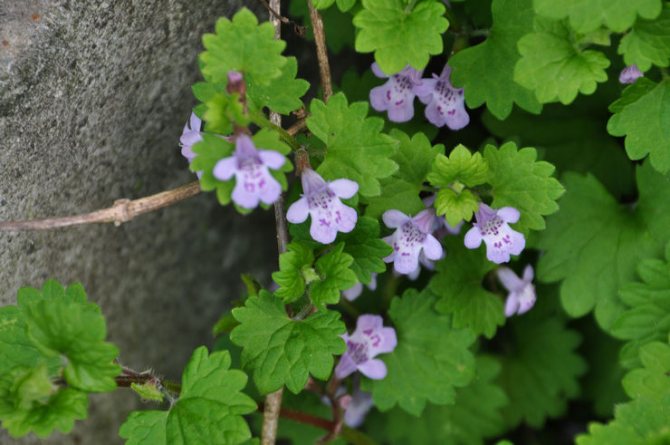

Budra can be grown on a garden plot in the open field, on a balcony or loggia, and also as a houseplant.
When kept on the balcony, you can use joint plantings with other plants (deciduous or flowering). When using form trimming, you can shape any shape. As an indoor flower budra looks great in a hanging planter or container. But on open flower beds or flower beds, catnip is grown as a ground cover plant, thereby creating a beautiful lawn or a dense grassy rug on the site.
This green perennial feels great under a snow cover in winter, and in May it begins to bloom actively, which attracts a large number of bees to its lilac or blue flowers. Honey from this melliferous plant is not only very beautiful in color, but also useful in composition.
Location and lighting
Budra prefers a location with bright and diffused lighting or light shading. A window sill on the south, south-west and south-east side of the room will be favorable for growing indoor buddha. In summer, the flower needs regular ventilation or "walks" in the fresh air, during which you need to take care of protection from direct sunlight. Outdoors, the growing area should be well lit and warmed up by the sun for a long time during the day.
Temperature
In spring, summer and autumn, the temperature will be in the range of 18-20 degrees Celsius, in winter - 10-15 degrees.
Watering and humidity
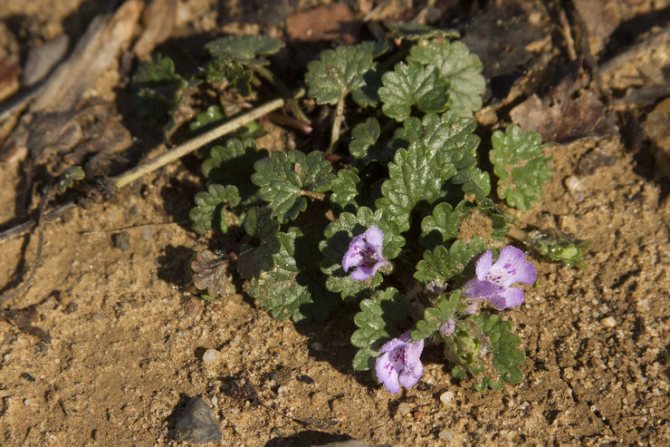

Boudre requires abundant watering and high humidity between March and October. The rest of the time, the frequency and volume of humidification (watering and spraying) are reduced.
The soil
On an open flower garden, budra can grow on almost all types of soil with moderate moisture. In room conditions, the soil mixture should consist of one part of leaf and sod land, as well as humus and half of a part of clean fine river sand.
Top dressing and fertilizers
Additional complex dressings are recommended to be applied during the period of increased growth of a houseplant from mid-spring to the end of the summer season, once a month.
Pruning
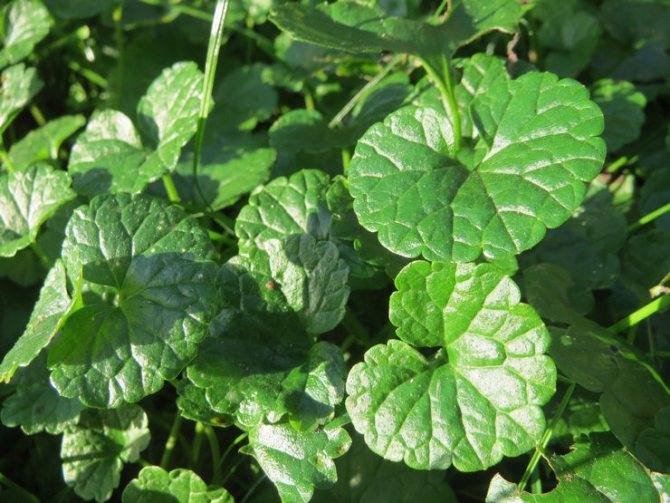

It is recommended to carry out formative pruning of budra before the active growth of the plant begins in early spring. The shoots that remain after such pruning can be used for propagation by cuttings.
Transfer
The frequency and time of transplantation depends on the growth and development of the culture and is not carried out regularly, but as needed.
Dormant period
The winter months are a dormant period for Budra. During this long rest, watering and feeding are almost completely stopped. All that is needed at this time is an average temperature of about 5 degrees Celsius, a bright room and light moistening of the soil.

